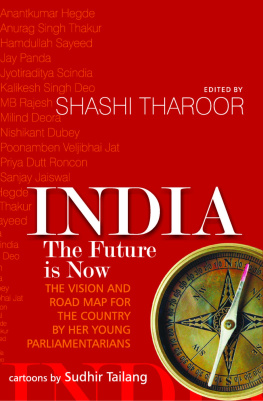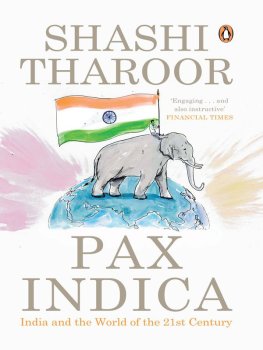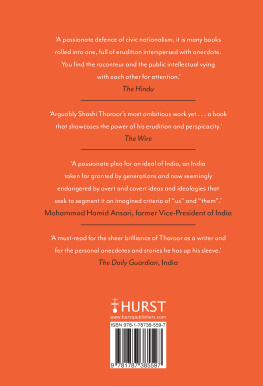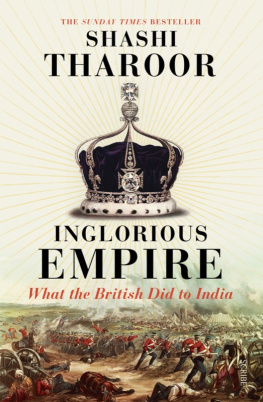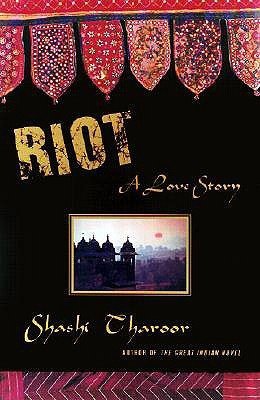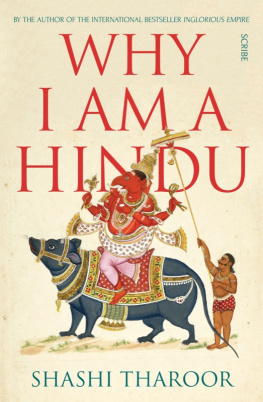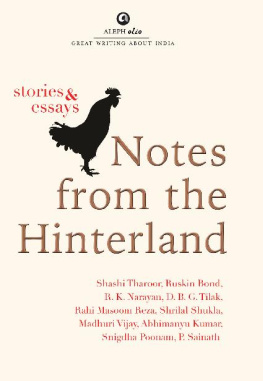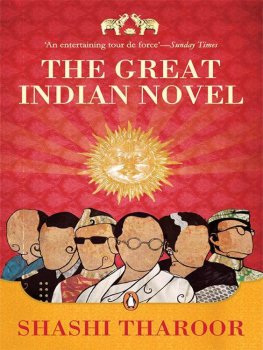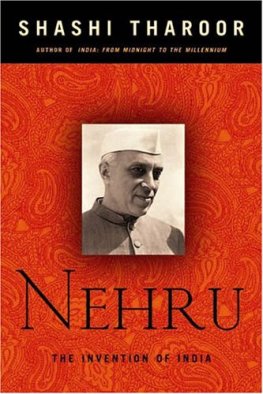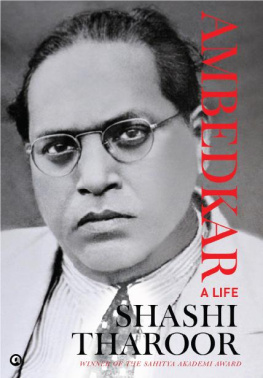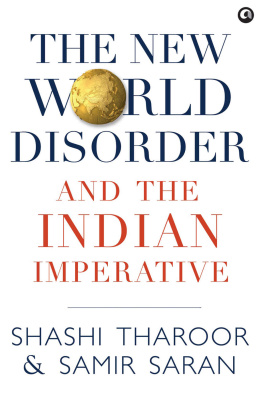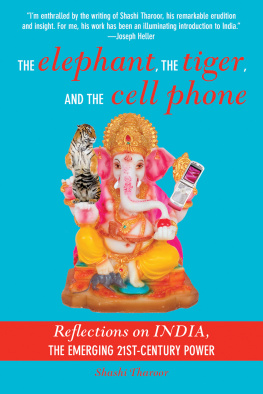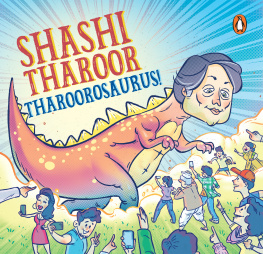Shashi Tharoor - India : The Future Is Now
Here you can read online Shashi Tharoor - India : The Future Is Now full text of the book (entire story) in english for free. Download pdf and epub, get meaning, cover and reviews about this ebook. year: 2013, publisher: Wisdom Tree Publishers, genre: Politics. Description of the work, (preface) as well as reviews are available. Best literature library LitArk.com created for fans of good reading and offers a wide selection of genres:
Romance novel
Science fiction
Adventure
Detective
Science
History
Home and family
Prose
Art
Politics
Computer
Non-fiction
Religion
Business
Children
Humor
Choose a favorite category and find really read worthwhile books. Enjoy immersion in the world of imagination, feel the emotions of the characters or learn something new for yourself, make an fascinating discovery.
- Book:India : The Future Is Now
- Author:
- Publisher:Wisdom Tree Publishers
- Genre:
- Year:2013
- Rating:3 / 5
- Favourites:Add to favourites
- Your mark:
- 60
- 1
- 2
- 3
- 4
- 5
India : The Future Is Now: summary, description and annotation
We offer to read an annotation, description, summary or preface (depends on what the author of the book "India : The Future Is Now" wrote himself). If you haven't found the necessary information about the book — write in the comments, we will try to find it.
India : The Future Is Now — read online for free the complete book (whole text) full work
Below is the text of the book, divided by pages. System saving the place of the last page read, allows you to conveniently read the book "India : The Future Is Now" online for free, without having to search again every time where you left off. Put a bookmark, and you can go to the page where you finished reading at any time.
Font size:
Interval:
Bookmark:



INDIA
THE FUTURE
is NOW

Text and photograph: Respective contributors
Cartoons: Sudhir Tailang
Conceptualisation: Shobit Arya
Editorial Coordination: Meenakshi Kumar
Wisdom Tree
First published 2013
All rights reserved. No part of this book may be reproduced, stored in a retrieval system or transmitted in any form or by any meanselectronic, mechanical, photocopying, recording or otherwisewithout the prior permission of the author and the publisher.
The views expressed are of individual contributors, they may not reflect the views of the publisher and the editor.
Although the contributors and publisher have made every effort to ensure that the information in this book was correct at the time of going to press, the contributors and publisher hereby disclaim any liability resulting from the use of any information contained herein.
ISBN 978-81-8328-336-6
Published by
Wisdom Tree
4779/23, Ansari Road
Darya Ganj, New Delhi-110002
Ph.: 011-23247966/67/68
wisdomtreebooks@gmail.com
Printed in India
Contents

Shashi Tharoor
|
An elected Member of Parliament from
Thiruvananthapuram, Shashi Tharoor is the Minister of State
for Human Resource Development, Government of India.
Tharoor graduated from St Stephens College, New Delhi and
finished his higher education with a doctorate from The Fletcher
School of Law and Diplomacy at Tufts University, USA. A former
Under-Secretary General of the UN, his twenty-nine-year-long
career at the United Nations included peace-keeping
and working with refugees.
In 1998, Tharoor was named a Global Leader of Tomorrow
by the World Economic Forum in Davos, Switzerland. He joined
Indias political cauldron in 2009. Tharoor was the Member-
Convener of the Parliamentary Forum on Disaster Management,
a Member of the Standing Committee on External Affairs,
the Consultative Committee on Defence, the Public Accounts
Committee and the Joint Parliamentary Committee on
Telecommunications. He is also a best-selling author, with
thirteen previous books. He has won numerous literary
awards, including a Commonwealth Writers Prize.

Young Leadership and the
Future of India
S HASHI T HAROOR
The young parliamentarians who have authored the dozen essays in this book have taken on a broad sweep of the nations problems. Anantkumar Hegde discusses agriculture, education and the environment. Anurag Singh Thakur focuses on national security. Hamdullah Sayeed, the youngest of the lot, concentrates entirely on education. Jay Panda, amongst the oldest, discusses economic growth (including the inevitable comparisons with China), education and caste politics. Jyotiraditya Scindias emphasis is on inclusive growth, with special reference to agriculture, education and social justice. Kalikesh Narayan Singh Deo discusses hunger, corruption and political change, particularly welcoming the role of regional parties. MB Rajesh offers a critique of economic reforms and suggests an alternative approach to addressing urgent problems of inequality. Milind Deora examines development at a time of rapid urbanisation. Nishikant Dubey seeks to bridge the urban-rural divide, particularly in skills, health and tourism. Poonamben Jat covers corruption, agriculture, education, human development and womens empowerment. Priya Dutt Roncon discusses education, health and the welfare of women and children. And Sanjay Jaiswal examines manufacturing, health and clean energy.
This is an impressive list, and it points to the urgent concern with Indias compelling problems that animates young Indian leaders across the countrys political divides. The contributors span the spectrum from left to right, represent both the Government and the Opposition and hail from both rural and urban constituencies. Their essays offer a good idea of the range and breadth of what young Indians with an eye on the future believe matters, as they navigate their way through the national political minefield.
For Indias challenges are considerable, and theres a reason why were still emerging, rather than, as President Obama so flatteringly put it in his November 2010 address to Parliament, already emerged. Our teeming cities overflow, while two out of three Indians still scratch a living from the soil. We have been recognised, for all practical purposes, as a leading nuclear power, but 400 million Indians still have no access to electricity and there are daily power cuts even in the nations capital. We are the worlds leading manufacturers of generic medication for illnesses such as AIDS, but we have 2.3 million people living with HIV-AIDS, another two million with tuberculosis and tens of millions with no health centre or clinic within ten kilometres of their places of residence. India holds both the world record for the number of cell phones sold, and also for the number of farmer suicides (an estimated 15,000 per year, because when harvests fail, farmers are crushed by a crippling mountain of debt and feel the only way out is to take their own lives).
And, as we all know, inflation, particularly of food and fuel prices, lurid stories of corruption and rising interest rates are causing concern to investors and have prompted some to see India less as an emerging market than as a submerging polity. There is no room for complacency.
Where do young political leaders in India fit into this uncertain future?
India is a remarkably young country. The nations average age is 28; indeed, 66 per cent of the population is under 35, which means that the young are already a majority in India. But they are not the ruling majority; according to The Economist, India holds the world record for the largest gap between the average age of the population and that of the Cabinet (which is 65). The young are entering leadership positions, but still with diffidenceand they continue to be outnumbered by their seniors.
And yet Indias youth population could be an asset unlike any other. We have a great demographic advantage in 600 million young people under 25, which means we should have a dynamic, youthful and productive workforce for the next forty years when the rest of the world is ageing. But we also have 60 million child labourers, and 56 per cent of the children in our government schools drop out by the eighth standard. We have trained world-class scientists and engineers, but 350 million of our compatriots are illiterate, and we also have more children who have not seen the inside of a school than any other country in the world does. We celebrate Indias IT triumphs, but information technology has employed a grand total of 5 million people in the last twenty years, while 10 million are entering the workforce each year and we dont have jobs for them. Many of our urban youth rightly say with confidence that their future will be better than their parents past, but there are Maoist insurgencies violently disturbing the peace in 165 of Indias 629 districts, and these are largely made up of unemployed young men.
Font size:
Interval:
Bookmark:
Similar books «India : The Future Is Now»
Look at similar books to India : The Future Is Now. We have selected literature similar in name and meaning in the hope of providing readers with more options to find new, interesting, not yet read works.
Discussion, reviews of the book India : The Future Is Now and just readers' own opinions. Leave your comments, write what you think about the work, its meaning or the main characters. Specify what exactly you liked and what you didn't like, and why you think so.

